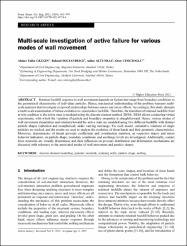| dc.contributor.author | Gezgin, Ahmet Talha | |
| dc.contributor.author | Soltanbeigi, Behzad | |
| dc.contributor.author | Altunbaş, Adlen | |
| dc.contributor.author | Çinicioğlu, Özer | |
| dc.date.accessioned | 2021-10-26T11:28:17Z | |
| dc.date.available | 2021-10-26T11:28:17Z | |
| dc.date.issued | 2021 | en_US |
| dc.identifier.citation | Gezgin, Ahmet T., Soltanbeigi, B., Altunbaş, A. ve Çinicioğlu, Ö. (2021). Multi-scale investigation of active failure for various modes of wall movement. Frontiers of Structural and Civil Engineering, 15(4), 961-979. https://dx.doi.org/10.1007/s11709-021-0738-4 | en_US |
| dc.identifier.issn | 2095-2430 | |
| dc.identifier.issn | 2095-2449 | |
| dc.identifier.uri | https://dx.doi.org/10.1007/s11709-021-0738-4 | |
| dc.identifier.uri | https://hdl.handle.net/20.500.12511/8522 | |
| dc.description.abstract | Retained backfill response to wall movement depends on factors that range from boundary conditions to the geometrical characteristic of individual particles. Hence, mechanical understanding of the problem warrants multi-scale analyses that investigate reciprocal relationships between macro and micro effects. Accordingly, this study attempts a multi-scale examination of failure evolution in cohesionless backfills. Therefore, the transition of retained backfills from at-rest condition to the active state is modeled using the discrete element method (DEM). DEM allows conducting virtual experiments, with which the variation of particle and boundary properties is straightforward. Hence, various modes of wall movement (translation and rotation) toward the active state are modeled using two different backfills with distinct particle shapes (spherical and nonspherical) under varying surcharge. For each model, cumulative rotations of single particles are tracked, and the results are used to analyze the evolution of shear bands and their geometric characteristics. Moreover, dependencies of lateral pressure coefficients and coordination numbers, as respective macro and micro behavior indicators, on particle shape, boundary conditions, and surcharge levels are investigated. Additionally, contact force networks are visually determined, and their influences on pressure distribution and deformation mechanisms are discussed with reference to the associated modes of wall movement and particle shapes. | en_US |
| dc.language.iso | eng | en_US |
| dc.publisher | Higher Education Press | en_US |
| dc.rights | info:eu-repo/semantics/embargoedAccess | en_US |
| dc.subject | Arching | en_US |
| dc.subject | Discrete-Element Modelling | en_US |
| dc.subject | Granular Materials | en_US |
| dc.subject | Particle Shape | en_US |
| dc.subject | Retaining Walls | en_US |
| dc.title | Multi-scale investigation of active failure for various modes of wall movement | en_US |
| dc.type | article | en_US |
| dc.relation.ispartof | Frontiers of Structural and Civil Engineering | en_US |
| dc.department | İstanbul Medipol Üniversitesi, Mühendislik ve Doğa Bilimleri Fakültesi, İnşaat Mühendisliği Bölümü | en_US |
| dc.authorid | 0000-0003-4235-8310 | en_US |
| dc.identifier.volume | 15 | en_US |
| dc.identifier.issue | 4 | en_US |
| dc.identifier.startpage | 961 | en_US |
| dc.identifier.endpage | 979 | en_US |
| dc.relation.tubitak | info:eu-repo/grantAgreement/TUBITAK/SOBAG/119M849 | |
| dc.relation.publicationcategory | Makale - Uluslararası Hakemli Dergi - Kurum Öğretim Elemanı | en_US |
| dc.identifier.doi | 10.1007/s11709-021-0738-4 | en_US |
| dc.identifier.wosquality | Q3 | en_US |
| dc.identifier.scopusquality | Q1 | en_US |


















